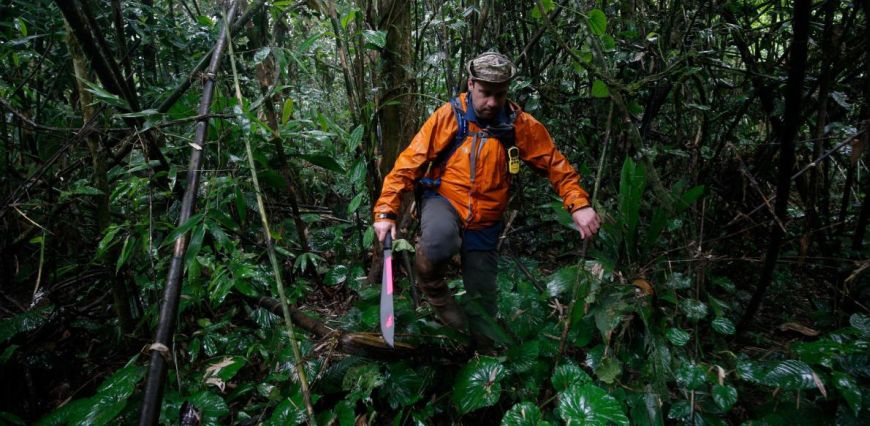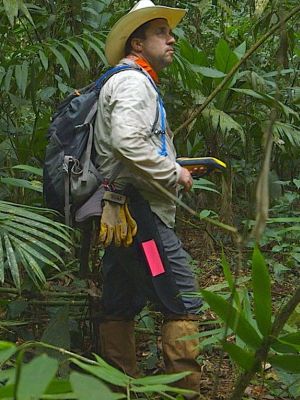
When Chris Fisher left the Honduran jungle in February, he packed with him two very important but vastly different things.
Unbeknownst to Fisher, a professor of archaeology in the Department of Anthropology at CSU, he had been infected by leishmaniasis, a parasite-borne tropical disease that literally can eat away the flesh of its victims. It took a week of chemotherapy-like treatments at the National Institutes of Health in Washington, D.C. to halt the disease’s advances.
“It’s the worst thing I’ve ever experienced,” Fisher said. “And the treatment is almost as bad.”
But while Fisher wouldn’t wish leishmaniasis on his worst enemy, he didn’t hesitate when asked if he would consider returning to the dense tropical rain forest in Honduras where he contracted the disease.
“Absolutely, I would go back,” he said. “In fact, I am going back.”
Thirst for knowledge, discovery
What force would entice a well-educated person to return to a place so remote, so dangerous and so unforgiving that the last known inhabitants abandoned it five centuries ago? Simple: The thirst for knowledge and the thrill of discovery. Fisher and an international team of scientists and adventurers have found evidence of a potentially spectacular archaeological find.

Fisher has received a $100,000 grant from the National Geographic Society to begin a joint Honduran/CSU project to excavate a site deep in the Mosquitia tropical wilderness of Honduras. In addition, Honduran President Juan Orlando Hernández pledged nearly a million dollars to support archaeology and conservation in the region, some of which will help with the upcoming excavation.
Fisher and his team will spend of part of December and most of January at the site excavating an area first discovered using LiDAR (light detention and ranging). Fisher used LiDAR to aid in the discovery of an ancient city in western Mexico that was part of the Purépecha Empire, and the team organizing the exploration of the Honduran site sought his expertise to unravel the mysteries that lie beneath the dense jungle canopy.
The story of the original expedition was told by Douglas Preston in the October issue of National Geographic. It was also the topic of a recent episode of the New National Geographic Explorer, which debuted October 4th on the National Geographic Channel.
Evidence of lost city
Fisher and a team that included anthropologists, film makers, ethnobotanists, a geochemist and a geographer, hacked their way into the jungle in the Mosquitia region in February and began mapping the site. During their short stay they discovered 52 perfectly preserved artifacts on the surface and evidence of pyramids, roads, plazas – everything you expect to find in an ancient city.
Since that time, President Hernández has committed soldiers to guard the site to prevent looting. He understands the importance of the discovery in a place struggling with widespread poverty, and an exciting discovery could boost tourism in a country that lacks economic firepower.
Fisher awarded President Hernández with the 2015 Colorado State University Latin American Conservation Award at the national palace in Tegucigalpa in October.
Two goals: Discovery, conservation
For Fisher, the mission is two-fold.
An expert in Mesoamerican culture, Fisher hopes excavating the city – or cities – will provide important clues about the Mosquitia people, about whom little is known.
“The potential for discovery is tremendously exciting,” he said. “We have no idea what we will find, but we should learn a great deal about these people and, hopefully, why they abandoned this area.”
Second, Fisher is hoping the discovery leads to increased awareness about deforestation in one of the world’s largest sections of unspoiled rainforest. Ranchers seeking land to graze cattle have been stripping the area of trees for years, leaving the land scarred and once-abundant wildlife fauna threatened.
“Fortunately, the president is very aware of this situation and determined to bring deforestation under control, thanks to these discoveries,” Fisher said.
Fisher’s biggest challenge – beyond avoiding deadly snakes and jaguars – will be finding a team to support the excavation. The threat of leishmaniasis is real, as nearly 50 percent of people who have visited the site have contracted the disease.
“I should be OK because you build up immunities to it once you’ve had it,” he said. “But for people who haven’t had it, it’s a scary deal. Not many people are racing to sign up to go back there when the chance of infection is so high.”